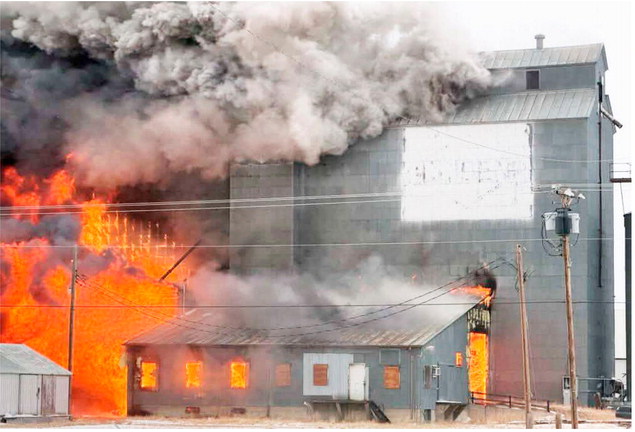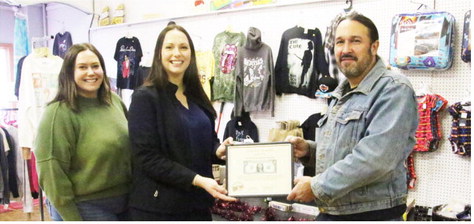Federal Cuts Halt Indian Boarding School Digitization Effort


When Iko’tsimiskimaki “Ekoo” Beck’s colleagues at the National Native American Boarding School Healing Coalition traveled to Washington to digitize Indian boarding school records, Beck asked them to search for their late great-aunt, Irene Wall.
Wall, who was Blackfeet and grew up in Browning, attended Chemawa Indian School in Oregon in the 1950s with her sister. Sifting through thousands of boarding school records at the National Archives in Seattle, Beck’s colleagues found a letter, dated Nov. 10, 1954, from Wall’s father, Beck’s great-grandfather.
“Dear Sir,” Thomas Wall wrote to school officials in fragmented sentences. “Could you please kindly send two of my girl home. I send one of them their money to come home on. That is Irene Wall. And later on this week I’ll get the other one money I’ll send to her too. But I send Irene Wall money now and you send her home this week.”
Before finding the letter, Beck said she and her family didn’t have much information about Wall’s experience at boarding school.
“You get things here and there from certain elders, but you always wonder,” Beck said.
For more than a year, the National Native American Boarding School Healing Coalition (NABS) had been working on a grant-funded project to digitize and make publicly available thousands of records from Indian boarding schools.
That project, called the National Indian Boarding School Digital Archive, was one of many boarding school initiatives halted when the Trump administration implemented mass layoffs and slashed funding for the National Endowment for the Humanities (NEH). The Associated Press reported that at least $1.6 million meant to support boarding school healing projects was cut via grants canceled by the NEH.
Mark Macarro, president of the National Congress of American Indians, called the cuts “a betrayal.”
“We will not allow the federal government to erase or defund truth,” he said in a May 5 statement.
Without funding, the National Indian Boarding School Digital Archive initiative stalled. Some people working on the project lost their jobs. The group halted partnerships and canceled community events. Now, about 75,000 pages of boarding school records sit in online storage systems that, according to NABS Digital Archives Manager Fallon Carey, “can’t be touched until we get new funding.”
Tribal leaders say the funding cuts disrupt critical healing processes for boarding school survivors, families and tribes, and keep the general public from learning the truth about what happened at these schools.
“This is the history of Indigenous peoples, but it’s actually also American history,” Carey told Montana Free Press in April. “This is the history of this country. It’s the truth.”
Indian Boarding Schools
From the 1800s to the 1970s, Native American children were taken from their homes and forced to attend boarding schools run by the federal government, where the explicit mission was cultural genocide. While 16 boarding schools operated in Montana, tribal members in the state were also sent across the country to attend schools like Carlisle Indian Industrial School in Pennsylvania, Sherman Institute in California, and Haskell Institute in Kansas, among others. At these schools, Indigenous children were punished for speaking their languages and practicing their cultures. They were emotionally, physically and sexually abused. Some children died at Indian boarding schools and were buried in unmarked graves.
The boarding school era has far-reaching consequences in tribal communities today. Tribes nationwide experienced language and culture loss as a result of boarding schools. Three of 12 Indigenous languages in Montana are considered critically endangered, meaning the youngest speakers are elders who speak the language infrequently, according to a 2020 Montana Budget and Policy Center report. Several studies trace the origin of current health disparities to the boarding school era. In Montana, Native Americans die about 17 years sooner than their white neighbors. Experts also say boarding schools disrupted traditional ways of parenting. State Sen. Susan Webber, D-Browning, has said she does not trust herself to discipline her own children because of the abuse she endured while at a boarding school.
Indian boarding school, she said in a recent interview with Montana Free Press, “is the flashpoint of all our ills.”
Tribal leaders have for years urged reconciliation at the national and state levels, saying the history of boarding schools must be publicly acknowledged to promote healing. And in recent years, mainstream national political and religious leaders have started to reckon with that history. In 2021, former Interior Secretary Deb Haaland launched the Federal Indian Boarding School Initiative to recognize the history of the schools and address the trauma they inflicted. In 2022, Pope Francis traveled to Canada to apologize for “the evil committed by so many Christians against Indigenous peoples.” And in 2024, former President Joe Biden apologized for the government’s role in operating Indian boarding schools.
At the state level, Webber in the 2023 legislative session successfully advanced a resolution urging Montanans to “recognize the grief, pain and hardship many Native American people suffered and still endure as a result” of the boarding school era. And several tribes in Montana have worked to bring home the remains of members who died while attending boarding schools across the country.
Digitizing Records
Before the federal cuts, NABS staff working on the digitization project had visited several National Archives locations and digitized about 75,000 pages of records. The organization had partnered with other groups and held community events to raise awareness for the work.
Those working on the project digitized letters written between school officials and government leaders. They found correspondence between school superintendents and local law enforcement, often discussing students who ran away. They scanned letters from worried parents asking about their children and letters from children begging to return home. Some records misspelled students’ names, misidentified student’s tribal affiliation or incorrectly documented the circumstances of their deaths.
“When you’re working with records that were captured and created by culturally ignorant people who are running these schools, there are going to be a lot of mistakes,” Carey said, adding that school records rarely portray Indigenous children in a positive light, often providing a one-sided view of history.
Letters between children and their parents, Carey said, stand out for their humanity. She said she got goosebumps at one community event where two cousins for the first time read letters their relative had written home.
“It’s really beneficial and really impactful for the families to get access to these records,” she said. “… People were crying because it was so emotional.”
NABS staff were on track to finish the digitization project by December, but President Donald Trump’s sweeping cuts halted the effort. A final trip to the National Archives at Kansas City was canceled. About $282,000 of the $500,000 grant was lost. Two part-time catalogers and one grant sub-awardee were laid off. NABS had to terminate agreements with Dickinson College in Pennsylvania, which runs the Carlisle Indian School Digital Resource Center, and with the Saginaw Chippewa Indian Tribe of Michigan, which operates the Ziibiwing Center to promote history and culture. Community events and listening sessions were canceled. And because NABS lost funding to process and catalog records, survivors and their families are not able to access the digitized information.
“This is effectively shutting down access for communities to their own information that the federal government holds,” Beck told Montana Free Press in a recent interview.
Jake Arrowtopknot — a teacher at Buffalo Hide Academy, a public school on the Blackfeet Reservation — uses boarding school records in his classroom. Both sets of his grandparents attended boarding schools, and the trauma they endured is ever-present.
“There’s a particular type of heater my grandma used to see and joke, ‘Oh boy. I used to be tied up to a bunch of those,’” he said, referencing the abuse his grandmother experienced at boarding school. “It becomes nebulous in a way, because everyone has that story. There’s about 15 kids with similar anecdotes. A weird thing happens with collective pain — we all deal with it, but we don’t know what to do with it.”
One way to deal with that pain, Arrowtopknot said, is to talk about it and to teach about it. He and his students research their family trees and identify the boarding schools their relatives attended. Through the exercise, he recently learned that several of his relatives attended Carlisle — a school whose founder coined the phrase “kill the Indian, save the man” to justify assimilation.
“Even that was such a powerful framing device,” Arrowtopknot said of learning his relatives’ history. “This is where generations of hurt come from. When you make that visible to kids, you track that pain and show them there’s a source to it.”
The digitization effort, Arrowtopknot said, would’ve been an invaluable resource for his students. With records, students could learn more about their relatives’ experiences, and in turn, learn more about themselves and where they come from. The recent cuts, Arrowtopknot said, “are a slap in the face.”
“That is Trump saying, ‘Brown Indian kids do not matter,’” he said. “It’s plain as day.”


